When planning for retirement, many people wonder if having a million dollars in savings will be enough to enjoy a comfortable and financially secure life. While one million dollars is often considered a significant milestone, whether it will suffice depends on various factors, including your lifestyle, location, health care needs, and investment strategies. This article will explore what retirement might look like with one million dollars, providing insights into how to manage, budget, and maximize these savings to ensure a comfortable and fulfilling retirement.
1. The Duration of Retirement: A Crucial Factor
One of the most important aspects to consider is the length of your retirement. As life expectancy increases, many people retire in their 60s and live well into their 80s or even 90s. This means your retirement savings may need to last 20, 30 years, or even longer. Here’s how this impacts your retirement planning:
- Estimating Life Expectancy: Based on your health and family history, you may live longer than expected. Planning for a longer life is crucial, so it’s wise to assume your retirement could last at least 30 years.
- Longevity Risk: The longer your retirement, the greater the risk of outliving your savings. A million dollars may be enough for a retirement spanning 15 to 20 years, but it could fall short for a 30-year or longer retirement, especially with inflation and unexpected expenses in play.
2. Annual Expenses: Creating a Realistic Budget
The key to living comfortably in retirement with one million dollars is understanding your annual expenses. Retirees’ needs and wants can vary significantly, but here are some basic costs to consider:
- Housing Costs: If your home is fully paid off, your housing expenses will be significantly reduced. However, you’ll still need to account for property taxes, homeowner’s insurance, maintenance, and utilities. If you rent or have an outstanding mortgage, these costs will be higher.
- Healthcare: Healthcare expenses are among the most unpredictable and potentially high costs for retirees. Even with Medicare (in the U.S.) or similar programs in other countries, there may be out-of-pocket costs, deductibles, and uncovered care. Supplemental health insurance is recommended.
- Leisure and Travel: Leisure is an important part of retirement. Whether you enjoy traveling, playing golf, or attending cultural events, these activities come with a cost. A typical budget for leisure might range from $5,000 to $15,000 or more per year.
- Food and Transportation: Costs for groceries, vehicles, and public transportation can add up. Plan for around $5,000 to $10,000 annually for these needs, depending on your lifestyle.
By creating a realistic budget, you can estimate how long your retirement savings will last. For instance, with a million dollars and an annual expense budget of $40,000, your funds could last about 25 years, assuming moderate investment returns.
3. Investment Strategies in Retirement
Managing a one-million-dollar portfolio in retirement requires a prudent investment strategy to avoid depleting the capital while generating sufficient income. Here are some common strategies:
- Diversification: Maintain a diversified portfolio that includes stocks, bonds, index funds, and possibly real estate. Diversification helps balance risk and benefit from market returns.
- 4% Withdrawal Rule: A commonly used method by retirees is the 4% rule, where you withdraw 4% of your initial portfolio in the first year, then adjust that amount for inflation each following year. This method can help ensure your capital lasts for at least 30 years.
- Bonds and Fixed-Income Products: Including bonds and fixed-income products in your portfolio can provide a stable source of income and reduce the volatility of stocks.
- Regular Rebalancing: Review your portfolio at least once a year to rebalance your assets according to your risk tolerance and retirement goals. Rebalancing helps maintain the right level of risk and capture gains from stocks that have performed well.
suggestion : The 4% Rule: Guide to Financial Retirement
4. The Impact of Inflation
Inflation is a critical factor that can erode the purchasing power of your retirement savings over time. With an average inflation rate of 2% to 3% per year, living costs could double in 24 to 36 years. Here’s how to protect against inflation:
- Inflation-Protected Investments: Invest in assets that offer protection against inflation, such as Treasury Inflation-Protected Securities (TIPS) or real estate. These assets can help offset the impact of rising prices.
- Stocks: While stocks are more volatile, they have historically outperformed inflation in the long run. Having part of your portfolio in equities can provide growth that offsets inflation.
- Income Increases: Consider income sources that increase with inflation, such as inflation-indexed pensions or annuities with automatic adjustments.
5. Supplementing Retirement Income
Aside from personal savings, there are other income sources you can access to supplement your retirement funds. Here are some options:
- Social Security and Pensions: In many countries, social security systems and pensions provide a regular income stream for retirees. Understand how these payments fit into your overall retirement budget and plan accordingly.
- Part-Time Work or Consulting: Many retirees choose to work part-time or become consultants. This not only provides additional income but also keeps you active and engaged. This extra income can help preserve your principal capital.
- Rental Income: Investing in rental properties or renting out part of your primary residence can provide a stable passive income.
6. Housing Options in Retirement
Your housing choice can significantly impact your retirement budget. Here are some common options:
- Staying in Your Current Home: If your home is paid off and suits your needs, staying put may be the most economical option. However, maintenance and ownership costs must be considered.
- Relocating to a Lower-Cost Area: Many retirees opt to move to regions where the cost of living is lower. This can free up additional funds for other retirement expenses.
- Living in a Retirement Community: These communities offer services and activities geared towards retirees. Costs vary, but they can provide a social and supportive environment.
- Living Abroad: Some retirees choose to live in countries where the cost of living is much lower. This can allow for a comfortable lifestyle with fewer expenses.
7. Risk Management and Estate Planning
Risk management and estate planning are essential to protect your wealth and loved ones. Here are some steps to consider:
- Insurance: Ensure you have adequate coverage for health insurance, homeowner’s insurance, and liability insurance. Consider long-term care insurance to cover potential extended healthcare costs.
- Wills and Trusts: Create a will and consider trusts to manage the distribution of your assets. Estate planning helps minimize taxes and ensures your wishes are respected.
- Advance Medical Directives: These documents outline your healthcare wishes in case you become unable to make decisions yourself. They provide clear instructions to your loved ones and healthcare professionals.
8. Quality of Life in Retirement
Finally, focusing on the quality of life during retirement is essential. Here are some tips for enjoying a fulfilling retirement with one million dollars:
- Stay Active: Regular physical activity, such as walking, yoga, or golf, improves mental and physical health. Engage in activities you enjoy.
- Cultivate Social Connections: Maintain relationships with family and friends, participate in community activities, and join clubs or groups to stay socially active.
- Pursue Hobbies and Passions: Retirement is an excellent time to explore hobbies and passions that you may not have had time for during your working years. Whether it’s traveling, volunteering, gardening, or learning new skills, these activities can bring joy and fulfillment.
- Stay Financially Disciplined: Continue to monitor your budget, adjust your spending as necessary, and stay informed about your investments. Financial discipline ensures your retirement funds last as long as possible.
Conclusion
Retiring with one million dollars is achievable and can provide a comfortable lifestyle, but it requires careful planning, disciplined budgeting, and strategic investments. By considering factors like the duration of retirement, annual expenses, investment strategies, inflation, and supplemental income, you can create a sustainable retirement plan. Ultimately, the key to a fulfilling retirement is not just the amount of money you have but how effectively you manage and enjoy the resources available to you.






[…] LEAN MORE : What Does a $1 Million Retirement Look Like? […]
[…] LEARN MORE : What Does a $1 Million Retirement Look Like? […]